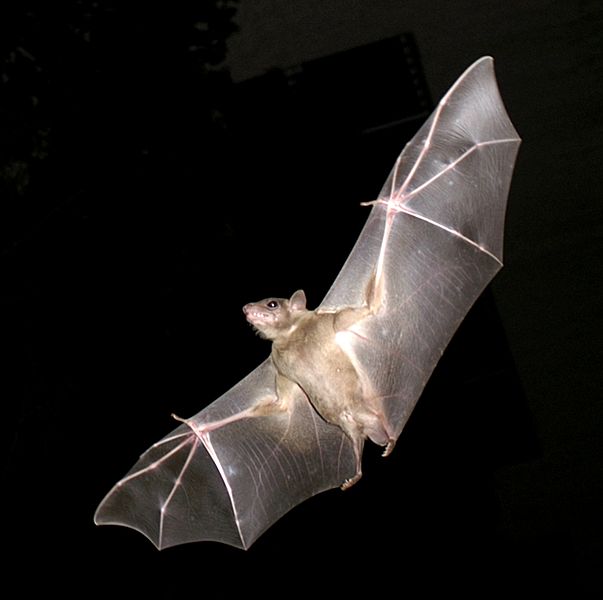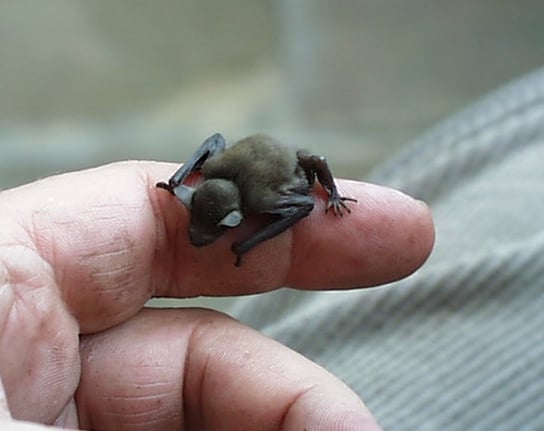I'm not going to try to convince her to invite them in for tea or anything, but I thought I'd write her up a blog post about bats for two reasons. One - bats are a really important part of the ecosystem (which she knows, but just doesn't want them in her house - which is fair enough) and Two - I can post lots of bat pictures which she will just love (this is sarcasm by the way). Really it's a win-win (it's ok, my family has that type of humour).
 |
| Just to get us started! pic from here |
On our trip to Wisconsin (where Aunt Mary is) we did a lot of sitting around the campfire, catching up, reminiscing, singing and telling a lot of humorous stories. It was during one of these fireside gatherings that Aunt Mary told us her true feelings about bats, funnily enough while a large number of them whizzed around above us. The specific story involved the original cottage on their property, which was home to a great number of creatures besides themselves - including some bats. One night there was one flying around indoors but luckily Uncle Al managed to trap it. However, when Aunt Mary went in to the bathroom there he was in all his bat glory, between the window pane and screen, pressed up against the glass, watching her every move. That old cottage has since been replaced and the bats (for the most part) relocated to a snazzy new bat house, so the incidences of house bats has greatly decreased (but maybe my dad heard a few in the soffits, shhhh....).
As with most things in this blog, it'll be fairly Great-Lakes-Region-centric because that's where I am and what I know. And one thing I noticed about the area of Wisconsin we were in is that boy, does it ever look like our area of central Ontario. The plant species, timing and overall ecology were very similar - which makes sense when you consider where we are and where they are happen to be directly across from each other (with a few big lakes in the middle, which makes driving there a bit awkward).
So, bats. They get a bit of a bad rap, what with the whole scrunchy face thing and vampire connections and Beans' hero Batman, while giving a heroic spin on bats, still plays up the whole darkness and living in a cave thing. But bats here are insectivores, preying quite a bit on mosquitoes - so they are quite handy to have around on a spring or summer evening around a campfire.
I invite Aunt Mary and you to meet our local bats:
The largest bat we have is the Hoary Bat, which means frosted (like hoar-frost) because it has white-tipped hairs. They are tree dwellers and because they are larger they eat larger insects - like dragonflies, beetles, and moths.

Big Brown Bats are also here (and the majority of Canada). They are hibernators, so they are here year round in mines and caves.
Little Brown Bats (such creative names...) are the most common bat in Canada.
Northern Long-eared Myotis. Another cave hibernator.
Red Bat. A solitary bat which migrates south in groups in the fall and winter. This one roosts in trees and shrubs in the winter.
Silver-haired Bat. Looks a bit like the Hoary, but is dark brown with white "frosting" on the back and abdomen. A forest dweller in southern Canada and roosts in logs or under bark. It likes to eat moths and migrates south in winter.
Tri-coloured Bat (Eastern Pipistrelle) is the smallest bat we have and is multicoloured - grey, yellow and brown. Another cave hibernator.
Eastern Small-footed Myotis is another little guy and the least common we have here in Canada. It's a late hibernator and has a slow, erratic flight.
All bat mugshots were borrowed from here: http://www.batcon.org/ - they have lots of species listed as well as ranges, so you could find some bats near you.
Super Awesome BAT Facts:
- Bats are the only flying mammal in the world. Others can glide but no one else can do sustained flight.
- Bats can live up to 20-30 years.
- The smallest bat in the world is Kitti's Hog-nosed Bat (Craseonycteris thonglongyai) aka the "bumblebee bat" from Thailand and Burma. At 29 to 33 mm in length and weighing in at a teensy 2g it may also be the worlds smallest mammal!
- The largest bats in the world are the Flying Foxes, with wingspans reaching 2m. They belong to the aptly named "megabat" suborder and eat nectar, pollen and fruit. They do not use echolocation like their "microbat" counterparts.
 |
| Kitti's Hog-nosed Bat |
 |
| Spectacled Flying Fox |
- There are three species of vampire bats, which do indeed exist on blood. The common vampire bat (Desmodus rotundus), the hairy-legged vampire bat (Diphylla ecaudata), and the white-winged vampire bat (Diaemus youngi). All three species range from Mexico to Brazil, Chile, and Argentina.
- A brown bat can catch up to 1,200 insects an hour.
- There are 1,100 species of bats in the world.
- Bats have only one pup a year.
- Insectivore bats hunt by ecolocation - they produce sound waves that bounce off of their surroundings and help them navigate and locate prey.
Now for the sad PSA part of this post. There is a virus that is killing North American bats. It's called white-nosed syndrome (WNS) and is already responsible for millions of bat deaths. It is found in cave hibernating bats and is easily spread through the close quarters over the winter months. It causes them to have erratic behaviour and wake from hibernation - essentially starving them to death. Believed to have originated and spread by recreational cave exploration in the north-eastern US, it's now a serious problem that may wipe out some of these species. Please don't visit caves with bats (which is stressful for them anyway) and if you do please clean and disinfect all equipment before going to another cave. And report all sightings of WNS or unusual bat behaviour (links for more information below).
And now everyone together:
Twinkle, twinkle, little bat!
How I wonder what you're at!
Up above the world you fly,
Like a tea tray in the sky.
Twinkle, twinkle, little bat!
How I wonder what you're at!
-Lewis Carroll
Where we learned about bats:
http://www.hww.ca/en/species/mammals/bats.html
http://animal.discovery.com/mammals/13-incredible-bat-facts.htm
http://science.howstuffworks.com/zoology/mammals/bat2.htm
More on WNS:
http://www.mnr.gov.on.ca/stdprodconsume/groups/lr/@mnr/@fw/documents/document/278529.pdf
http://www.nwhc.usgs.gov/disease_information/white-nose_syndrome/
http://www.mnn.com/earth-matters/animals/videos/assignment-earth-white-nose-syndrome-in-bats







No comments:
Post a Comment